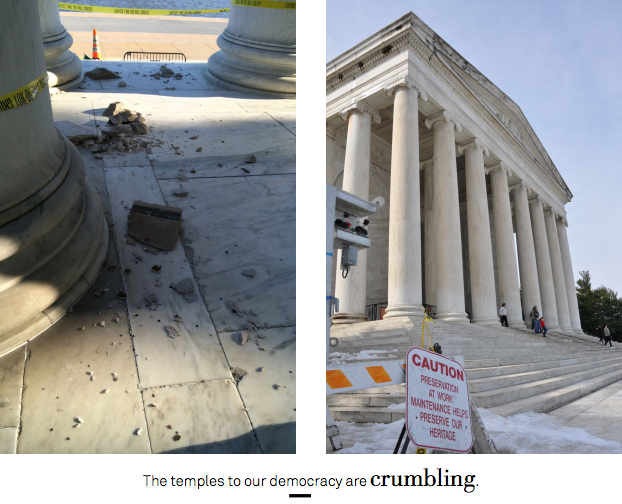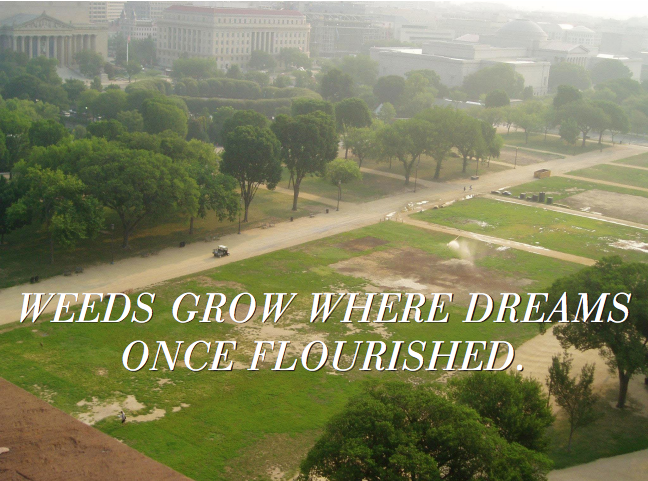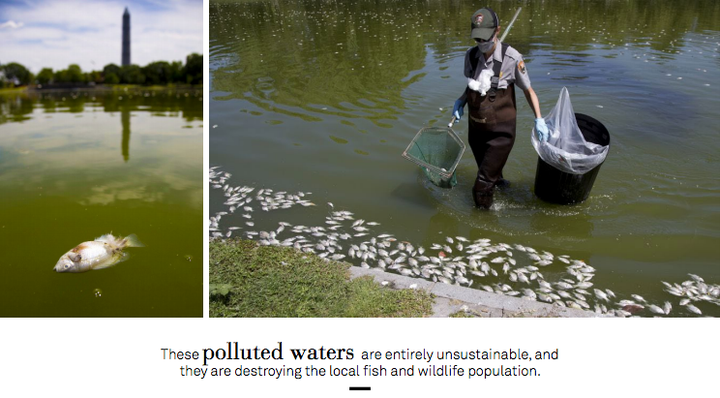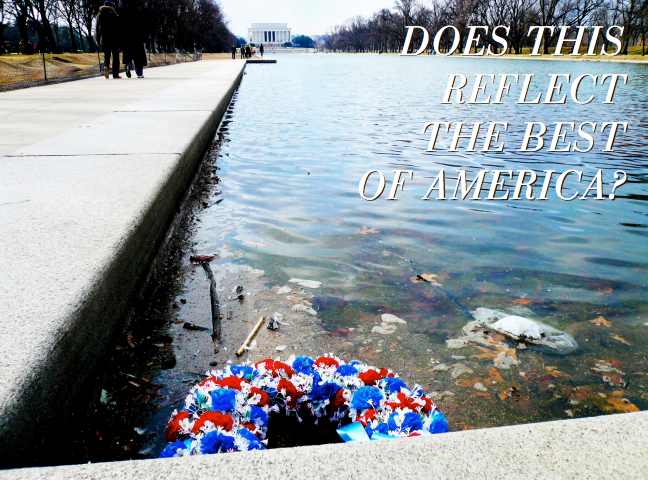Early one morning in April 2014, the water-damaged ceiling of the Jefferson Memorial portico finally surrendered to the elements, dropping a 5-foot-long, 3-foot-wide slab of limestone some 40 feet onto the marble floor below.
For months, the public didn't seem to notice. Then in October, a spokesman for the National Park Service -- which oversees the Jefferson Memorial and other monuments around Washington, D.C. -- confirmed that a faulty gutter system had allowed water to seep in from the structure's roof, eating away steel support beams until the ceiling could no longer hold the block.
It was the latest reminder that the National Mall is, both literally and figuratively, crumbling under the weight of its own decaying infrastructure.

Years of congressional budget cuts have exacerbated this issue on the Mall and at national parks around the country. Park Service officials regularly warn of the consequences of neglect in the face of a nationwide maintenance backlog that now exceeds $11 billion. Had the quarter-ton chunk of rock fallen in the afternoon, during the peak tourist season that surrounds the blooming of Washington's cherry blossoms each year, the oversight could have proved deadly. Instead, the warning incident was met with relative silence.
This weekend, a nonprofit dedicated to restoring, preserving and improving the nearly two-mile stretch of land between the U.S. Capitol and Lincoln Memorial -- including many of Washington's most iconic monuments -- is putting an end to that silence.
On Saturday and Sunday, the Trust for the National Mall, along with production group C3 Presents, will put the 700-acre park front and center at the inaugural Landmark Festival. Some of the nation's biggest musical acts will be on hand to send the message that nearly 40 years after the last large-scale restoration effort, "America's Front Yard" is in trouble. With the goal of raising awareness and money for the trust, 40 artists, including Drake, The Strokes and alt-J, are set to perform in West Potomac Park, a ward of the Memorial Parks just adjacent to the National Mall proper.
The concert is the trust's latest and perhaps most ambitious push to raise funds for a proposed $700 million facelift to the Mall. The blueprint includes more than $400 million in deferred maintenance, as well as plans for more extensive renovations and new construction across the park, like the trust's forthcoming revitalization of Constitution Gardens, a 38-acre site that connects the Lincoln Memorial's Reflecting Pool and the Vietnam Veterans Memorial. When construction is complete, the grounds will feature a winter ice skating rink, a brand-new pavilion and a rejuvenated lake that ideally won't kill its inhabitants.
The trust is responsible for raising half of the project's funds -- an even $350 million. Though Congress' chronic underfunding of the Park Service is largely to blame for the Mall's current state of disrepair, lawmakers have promised to come up with the rest.

The decision to organize a music festival marks a significant strategic departure for the trust, which launched in 2007 and has only 10 full-time employees. For years, it has pursued more traditional philanthropy, holding benefit luncheons, galas and other fundraisers to tap into the personal wealth that flows through the nation's capital.
But the trust has become increasingly aware that relying on this sort of benefaction underscores a broader concern with the National Mall's image.
The Park Service estimates that around 29 million people from around the globe visit the National Mall and Memorial Parks each year, making it one of the most popular tourist destinations in the country. However, the demographics of those visitors hardly match up with the U.S. or the rest of the world. In a commonly cited survey of Mall visitors in 2008, around 90 percent of all respondents identified as white. The average age of each visitor was nearly 50 years old.
Kristine Fitton, vice president of marketing and communications for the trust, said internal statistics suggest this trend has only continued over time. It may seem sadly fitting, then, that older, wealthier white people are primarily the ones supporting the preservation of an area used mostly by individuals who look like them. However, Fitton saw an opportunity for the Mall to step up its outreach to a younger, more diverse crowd.
"It's one of the most democratic spaces we have," she said. "It belongs to everyone, so everyone should have a stake or feel a sense of stewardship toward the National Mall."
And if you want to prove the Mall is cool for younger people too, what better way to do it than to put on a top-billed music festival right next door?
Drake will headline the Saturday show less than a week after releasing a new mixtape with rapper Future, and his appearance will come at the tail end of a tour that has brought him to some of the nation's biggest music festivals, including Coachella, in California, and Governor's Ball, in New York City. (While that puts Landmark Festival in good company, it's hard not to feel that bringing in Drake, a Canadian, to help save a celebrated U.S. landmark is at least a little awkward.)
To further modernize its outreach, the trust is launching a "virtual National Mall" website, which will allow users to create their own "monuments" honoring heroes in their lives and share their submissions on social media.
The concert will also fulfill many of the standard functions of a fundraising campaign. For example, people who purchase tickets, which start at $150 for a two-day pass and $105 for a single day, are placed on an email list -- likely to be groomed as future donors. (Fitton also pointed out that people who don't have tickets will be able to watch performances on large monitors set up outside the festival grounds.)
Washington hasn't seen an event of this scale and format in over a decade. Throughout the '90s and early aughts, the now-defunct radio station WHFS hosted the annual HFStival at RFK Stadium, attracting artists like the Foo Fighters, Green Day and the Red Hot Chili Peppers. The event moved to Maryland in 2005 and eventually closed shop for good in 2011.
The largest commercial music events in the area now typically take place in neighboring Virginia or Maryland. And while the Mall regularly plays host to well-attended concerts, they are often billed as free-speech rallies and rarely sell tickets or alcohol, which will be available at Landmark.
Now, Fitton says, a new generation of people from Washington and around the nation will have the opportunity to come together in the heart of D.C. for a cause that honors a part of the city's history, while contributing to its future.
"There are major structural and engineering problems with the monuments that do require a significant investment to address," she said. "And as a country, we have to decide how important these symbols are to us."

But the restoration effort isn't just about sentimentality, sustainability and keeping tourists from being crushed by disintegrating monuments. According to a Park Service report released last year, visitors to the Mall and other national parks in D.C. injected $610 million into the local economy in 2013. Overall visitors to the city in 2014 reportedly spent nearly $7 billion in total, Washington's tourist agency found.
Trash, pollution and structural and cosmetic deterioration in the Mall all wear on visitor satisfaction and may, by extension, even affect the city's general reputation.
Of course, if Congress were more attentive to the state of the Mall, the trust might not have needed to step in as caretaker for one of the city's most vital economic engines. Yet the congressional Park Service budget simply hasn't kept pace with the Mall's growing needs in recent years despite government studies showing that each dollar invested into the park system returns $10 to the U.S. economy.
Fitton says this shortfall has made the Park Service and other federal agencies increasingly receptive to the idea of turning to public-private partnerships for more immediate financial solutions.
"These friend groups have really sprung up to supplement government funding, because government funding is insufficient," she said. "And that's sort of the wave of the future."
While the trust aims to make Landmark Festival an annual Washington, D.C., event to benefit the Mall, a lot will depend on how this weekend goes. Music festivals are not always successful endeavors, and many struggle to turn a profit, especially early on when organizers haven't yet built a profile. The trust has partnered with PR firms to help them make the most out of this year's festival, and Fitton says she's optimistic, even though her expectations are realistic.
The trust is also hoping to do more than just make money this weekend. Its longer-term goals involve changing the way people think about the Mall. Part of that effort apparently means giving the public a brutally honest diagnosis of the park's current state. All of the photos included in this story are from the trust, and together they come pretty close to calling the Mall a barren wasteland overflowing with garbage, diseased wildlife and booby traps. Perhaps that's a more accurate description than most of us would like to believe.

Fitton also wants to challenge the Mall's reputation as a concert venue reserved only for formal events and the most extravagant tributes to Americanness. She traces some of the Mall's stiff perception back to a dispute over a free July 4 concert in 1983, when then-Interior Secretary James Watt indirectly banned The Beach Boys from playing, saying rock bands attracted "the wrong element."
"[From] now on, July Fourth will be a [traditional ceremony] for the family and for solid, clean American lives," Watt said at the time. In the end, Las Vegas performer Wayne Newton headlined the show, accompanied by the U.S. Army Blues Band.
While Watt's decision looks even more ridiculous today -- seriously, The Beach Boys were too rock 'n' roll? -- Fitton says aspects of that tradition live on. Most concerts on the Mall still tend to avoid controversy at all costs, and many feature fantastical displays of patriotism that cater to an audience that trends older, whiter and more conservative.
Last Veterans Day, for example, hundreds of thousands of attendees flocked to the Mall for the free Concert for Valor. Many ended up packing the surrounding streets to view the performances on Jumbotrons because there was no way to get within viewing distance of the stage, a common issue at larger events on the Mall. That show featured seemingly safe artists like Bruce Springsteen, Carrie Underwood and the Zac Brown Band, but even they managed to attract criticism. Some in particular questioned Springsteen's decision to play anti-war songs in front of the decidedly pro-military crowd.
Though the Landmark Festival's grounds may not provide the same picturesque backdrop as the Mall, Fitton believes the trust can help reset broader precedents about how to use the space. After all, the Mall's legacy has been shaped by events that took risks, challenged convention and unabashedly embraced First Amendment principles. Martin Luther King Jr. wasn't worried about pleasing everybody when he delivered his "I Have a Dream" speech on the steps of the Lincoln Memorial in 1963. Nor were the gay rights activists who unfurled the iconic AIDS Quilt across the Mall in 1987.
"I don't want young people to feel that the National Mall is like going to church, where everything has to be proper and you can't sing a song unless it's patriotic," Fitton said. "If you can offend anyone, you should do it on the National Mall."
